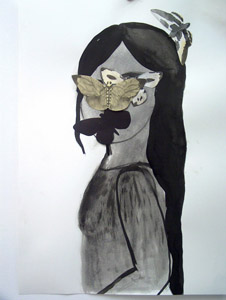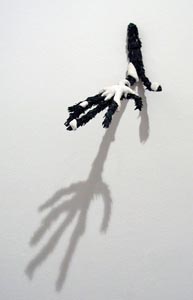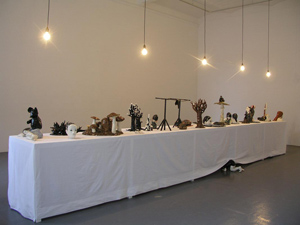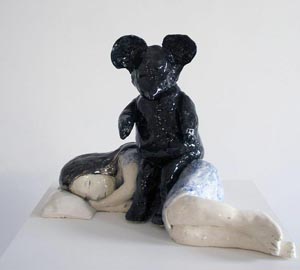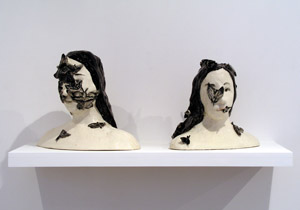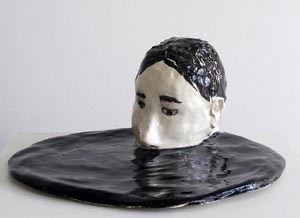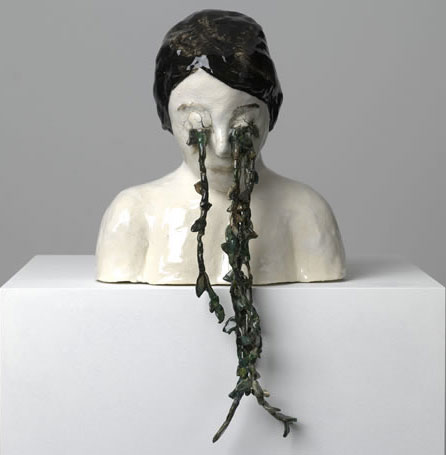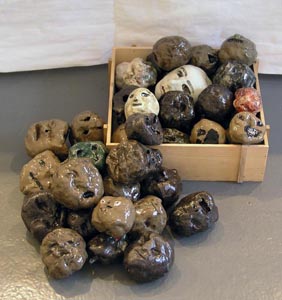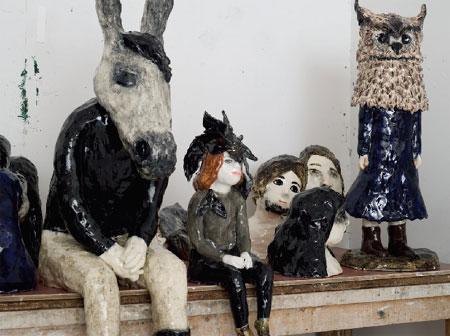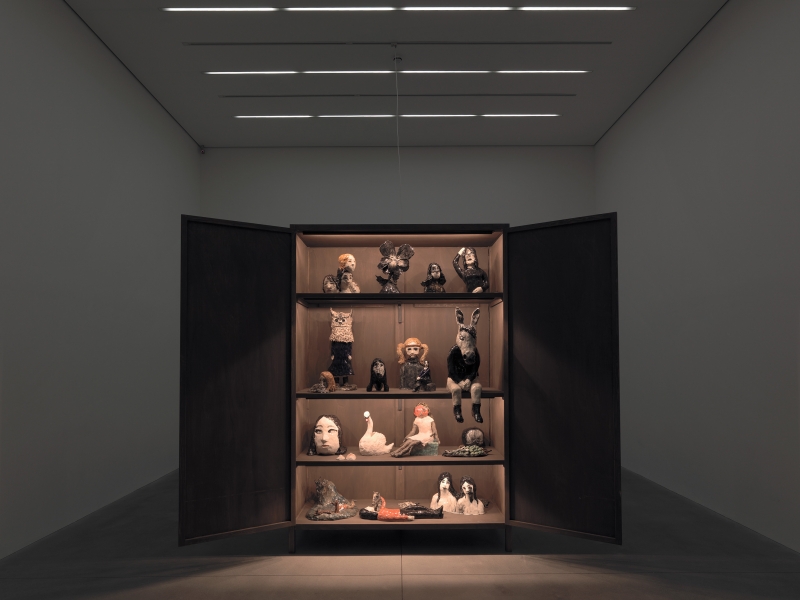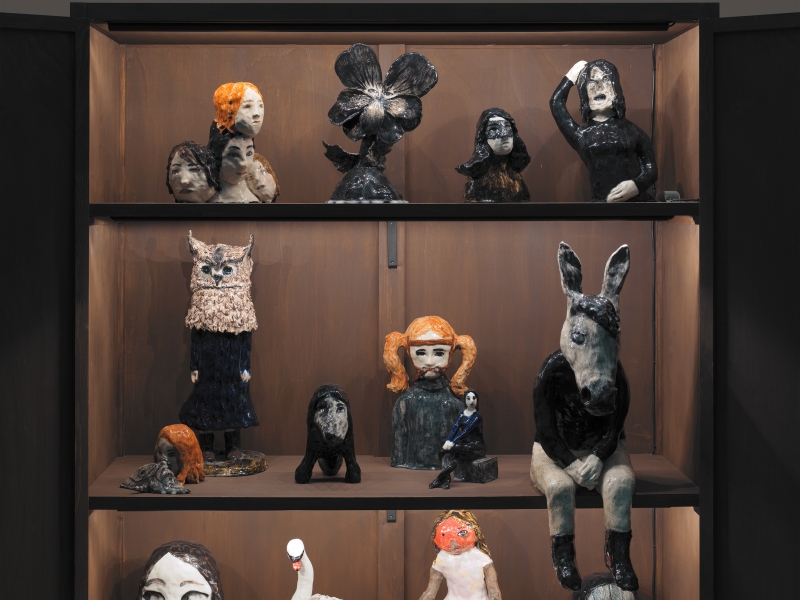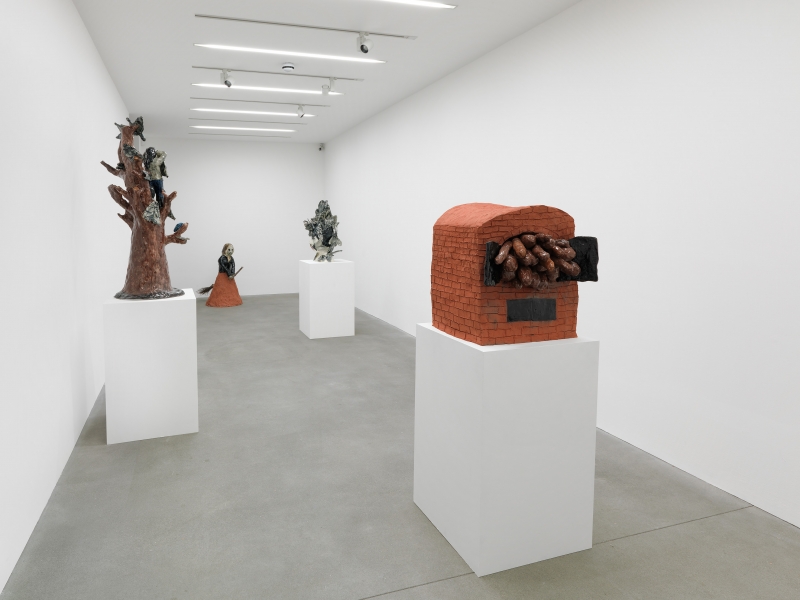IMAGES: KLARA KRISTALOVA Google Images
WEBSITES: KLARA KRISTALOVA
CONTACT: klara@kristalova.se
GALLERIES:
- Lehmann Maupin Gallery New York
- Galleri Magnus Karlsson Stockholm m.karlsson@telia.com /
- Galerie Emmanuel Perrotin Paris
- Alison Jacques Gallery London
LINKS:
Klara Kristalova: Where the Owls Spend their Days at Alison Jacques Gallery
VIDEOS:
- You Tube: http://www.youtube.com/watch?v=H4VmbxyJG7U Interview for San Franciso Art Museum Via Skype video chat, sculptor Klara Kristalova explains the ways the magic and terror of childhood and the struggles of becoming an adult have shaped the subjects of her work. See more videos at http://www.sfmoma.org/video
| Bibliography: | Sculpture Magazine July/August 2012 http://www.lehmannmaupin.com/#/press-artists/klara-kristalova/1/ |
BIO/CV:
Klara Kristalova was born in 1967 in Czechoslovakia. Lives and works in Norrtälje, Sweden. Kristalova studied at the Konsthogskolan Royal University College of Fine Arts, Sweden, graduating in 1994. She has exhibited internationally at the Nationalmuseum, Stockholm, Sweden (1997); Site Santa Fe, New Mexico (2009); and the Santa Barbara Contemporary Arts Forum, California (2009) among others. Recent exhibitions include White Blues at Kunstvereniging, Diepenheim, The Netherlands (2010); The House in my Head at Kunsthallen Brandts, Odense, Denmark (2010); Larger than Life, Stranger than Fiction at The 11th Fellbach Small Sculpture Triennial, Germany (2010); Luc Tuymans: A Vision of Central Europe, Bruge Central, Belgium (2010); The Magic of Clay, GI Holtegaard, Copenhagen, Denmark (2011); and SFMOMA’s New Work Series (2011). Kristalova’s work is included in numerous collections including the Moderna Museet/Modern Museum, Stockholm, Sweden, the Nationalmuseum, Stockholm, Sweden, Norrkopings Konstmuseum, Sweden. Klara Kristalova lives and works in Norrtälje, Sweden.
- SOLO EXHIBITIONS
2013 Västerâs Konstmuseum, Västerâs, Sweden
2012 Bonniers Konsthall, Stockholm, Sweden
“Black petals”, Galerie Perrotin, Paris, France
Göteborgs Konstmuseum, Göteborg, Sweden
2011 “Sounds of Dogs and Youth”, Lehmann Maupin Gallery, NY, USA
“New Work: Tiago Carneiro da Cunha & Klara Kristalova”, SFMOMA, San Francisco, USA
2010 FIAC booth, Galerie Perrotin, Paris
Galleri Magnus Karlsson, Stockholm
2009 Museum Site Santa Fe, USA
“Where the owls spend their days”, Galerie Alisson Jacques, London, UK
2008 Frieze Art Fair booth, Galerie Perrotin, London, UK
“Short Stories”, Galerie Perrotin, Paris, France
2007 “Two dark holes and other stories”, Galerie Perrotin, Miami, USA
“Catastrophes and other everyday events”, Galleri Magnus Karlsson, Stockholm, Sweden
“Visit”, Härnösands Konsthall, Sweden
2004 Galleri Magnus Karlsson;Stockholm, Sweden
Galleri PS, Göteborg, Sweden
Teatergalleriet, Uppsala, Sweden
2002 Galleri Magnus Karlsson, Stockholm, Sweden
2000 Olle Olsson huset, Hagalund, Solna, Sweden
1999 Galleri PS, Göteborg, Sweden
1998 Galleri Axel Mörner, Stockholm, Sweden
1996 Galleri TRE, Stockholm, Sweden
1995 Galleri PS, Göteborg, Sweden
1994 Bror Hjorts hus, Uppsala, Sweden
Galleri Mejan, Stockholm, Sweden
GROUP EXHIBITIONS : SELECTION
2011 “The magic of clay”, Glholtgaard Muaseum, Holte, Danemark
2010 “Larger than life – Stranger than fiction”, 11eme Fellbach Small Sculpture Triennial, Germany
“The House In My Head”, Kunsthallen Brandts, Odense, Danemark
“Soft white blues”, Kunstvereniging, Diepenheim, Netherlands
2009 “12 Suedoises sur la 14”, Métro Pyramides, ligne 14, Paris, France
“Le Sang d’un poète”, Biennale Estuaire Nantes / Saint-Nazaire (commissariat Frac des Pays de la Loire & Adam Budak), France
“L’artiste sorcier”, Fondation Salomon pour l’art contemporain, Annecy, France
“An Expanded Field of Opportunities” Santa Barbara Contemporary Arts Forum, Santa Barbara, USA
2007 “Past, Present, Future Perfect: Selections from the Ovitz Family Collection”, H&R Block Artspace, Kansas City, USA
“Effigies”, Stuart Shave Modern Art, London, UK
“Makers & Modelers: Works in Ceramic”, Barbara Gladstone Gallery, New York, USA
”Privat skulptur”, Studio 44, Stockholm, Sweden
”Barnet i samtidskonsten”, Haninge Konsthall, Stockholm, Sweden
”Grönska”, Mjellby Konstmuseum, Halmstad, Sweden
”20 år” Bonniers konsthall, Stockholm, Sweden
2006 ”Among gnomes and trolls”, Galleri Magnus Karlsson, Stockholm, Sweden
“Grönska”, Kristinehamns Konstmuseum, Sweden
2005 ”The gallery”, Galleri Magnus Karlsson, Stockholm, Sweden
”Svensk Konst Nu”, SAK on tour; Kalmar Konstmuseum, Konstens Hus, Luleå, Länsmuseet, Gävleborg, Skövde Konsthall, Sweden
2004 “Talking to me?” Rauma Biennale Balticum, Finland
Galleria Becker, Jyväskylä, Finland
2003 “4 Förslag”, Statens Konstråds galleri, Stockholm, Sweden
2002 “Blir du lonesome lille vän”, Konstnärshuset, Stockholm, Sweden
2001 “The World of Flash”, The Nunnery, London, England, UK
Sveriges Allmänna Konstförening, Stockholm
Reviews and texts:
2007 Sept 07 ”It’s just clay, how about a little respect?” New York Times
2007 Feb 03 Svenska Dagbladet,Kultur ”Kristalova pränger skulpturens ramar”, rewiew by Anna Brodow
2007 www.omkonst.se rewiew by Susanna Slöör
2007 www.konsten.net rewiew by Carina Redtzer
2007 Feb 21 Aftonbladet,kultur ”Nytt allvar – utan ironi” rewiew by Camilla Hammarström
2004 July 18 Turun Sanomat, rewiew of Rauma Baltic Biennale
2004 April 24 Uppsala Nya Tidning, ”Underfundigt och häpnadsväckande, rewiew by Frida Ängqvist
2004 Nov 20 Dagens Nyheter,kultur, ”Makt,myt och människa” rewiew by Jessica Kempe
2004 June 22 Uusi Aika, rewiew by RBB
2004 July 06 L.S. rewiew by RBB
2004 www.konsten.net rewiew by Anders Olofsson
2004 April 30 Norrtelje Tidning ”Lekfullt och underfundigt, rewiew by Margaretha Levin
2004 Nov 29 Norrtelje Tidning, kultur ”skulpturer som bjuder på oväntade möten”, rewiew by Margaretha Levin
2002 Oct 21 Norrtelje Tidning, kultur, ”Ögonblick och skiftningar” rewiew by Margaretha Levin
2000 Mar 26 Svenska dagbladet, kultur, guiden, ”Från måleri till skulptur” by Dan Backman
PRESS RELEASE Klara Kristalova Exhibition at Lehmann Maupin Gallery
Sounds of Dogs and Youth 540 West 26th Street
Lehmann Maupin Gallery is pleased to present Sounds of Dogs and Youth, Klara Kristalova’s first solo exhibition in New York, on view 27 October — 28 January, 2012 at 540 West 26th Street.
A skilled and imaginative storyteller, Klara Kristalova draws inspiration from music, current events, and her daily surroundings to create figurative ceramic works that often mirror imagery from myths and old folk tales, and address themes surrounding oppression, anxiety and the sub-conscious. Exuding both an innocence and horror, Kristalova’s uncanny sculptures portray adolescent girls and boys, often marked with exaggerated features or in the midst of transformation, and bring to mind memories of childhood fantasy, dreams and nightmares.
Through the medium of ceramic, described by Kristalova as having once been “seen as a low material, and not serious enough, especially when glazed,” the artist forms micro worlds with her sculptural figures and “relates to a sculpture tradition that has its roots several hundred years in the past. In this tradition the three dimensional artwork is seen as a means of three dimensionally ‘educating’ the viewer in a realm inhabited by both the viewer and the artwork simultaneously through their common physical relationship to the room,” as noted by art critic Anders Olofsson. For her exhibition at Lehmann Maupin, Kristalova presents new works in various mediums including ceramic, bronze, and works on paper in a setting envisioned to reflect the artist’s concept of an unsettling space. Kristalova has crafted the environment to create a surreal atmosphere that places viewers in a flux between a dreamy and surreal place, and an ordinary space where conversations and interactions occur. To achieve this effect, the artist has focused on lighting and has furnished the gallery with second hand furniture found at local flea markets.
WIKIPEDIA
Klara Kristalova
Klara Kristalova (born 1967) is a sculptor, who works mostly in ceramics. She plays upon the Meissen porcelain technique, working in a similar fashion but with larger figurines.[1] She lives and works in Sweden. She has exhibited internationally in solo and group shows in London, Paris, Miami, New York, Tokyo, Amsterdam, Santa Fe as part of Museum Site Santa Fe, Stockholm at the Nationalmuseum, and Santa Barbara in the Santa Barbara Contemporary Arts Forum.
Personal background
Klara Kristalova was born in Czechoslovakia and raised in Sweden; she currently lives and works in Norrtälje, Sweden. Her father is Czech artist Eugen Krajcik. She attended the Royal University College of Fine Arts, Stockholm.[2]
Professional background
Kristalova is known for her ceramic sculptures that have a fantastical quality while exploring darker narrative.[3] Traditional myths, fairy tales, and other literary sources such as Hans Christian Andersen, Selma Lagerlöf, Gösta Berling, old DC comics, and Oscar Wilde serve as an inspiration to her work. By using these works and adding her own twist, Kristalova explores memory, trauma, and the lost territory of childhood. Her characters are mostly girls, who morph into flora, fauna, and other natural elements.[4]
According to art critic Anders Olofsson, “Klara Kristalova is a storyteller who uses the plasticity of sculpture to build small micro worlds, where something peculiar has just happened or is about to happen. Here she relates to a sculpture tradition that has its roots several hundred years in the past. In this tradition the three dimensional artwork is seen as a means of three dimensionally “educating” the viewer in a realm inhabited by both the viewer and the artwork simultaneously through their common physical relationship to the room.”[5]
Kristalova has exhibited internationally in solo and group shows in London, Paris, Miami, New York, Tokyo, Amsterdam, Santa Fe as part of Site Santa Fe, Stockholm at the Nationalmuseum, and Santa Barbara in the Santa Barbara Contemporary Arts Forum. In late fall/winter of 2011, she will have a solo exhibition at Lehmann Maupin Gallery. She has created numerous public commissions in Sweden such as the memorial in the public garden park in Tungelsta, Stockholm; the entrance to Karlstad public park; and sculptures at Ostersunds University. Her work is part of public collections including the Moderna Museet/Modern Museum, Stockholm, Sweden and the Nationalmuseum, Stockholm, Sweden.[6]
References
- ^ Smith, Roberta. Makers and Modelers: Works in Ceramic, New York Times, 7 September 2007
- ^ Klara Kristalova Biography – Lehmann Maupin Gallery
- ^ Sonnenborn, Katie. “Makers and Modellers”, Frieze, March 2008
- ^ Hubbard, Sue. New Work: Klara Kirstalova, Art World, June/July 2009.
- ^ Olofsson, Anders. “Klara Kristalova Sculptures” in Klara Kristalova, ed. Raphael Gatel, (Paris: Karlsson/Perrotin, 2007) ISBN 978-2-9532797-4-0.
- ^ Klara Kristalova Biography, Alison Jacques Gallery
External links
- Klara Kristalova Official Website
- Lehmann Maupin Gallery
- Alison Jacques Gallery
- Galerie Emmanuel Perrotin
- SITE Santa Fe
- Santa Barbara Contemporary Arts Forum
- Nationalmuseum Stockholm
- {http://tmagazine.blogs.nytimes.com/tag/klara-kristalova/?scp=1&sq=klara%20kristalova&st=cse T Magazine, New York Times]
Klara Kristalova
From: http://www.aptglobal.org/view/artist.asp?ID=6319
Born in 1967 in Prague, Czechoslovakia, Klara Kristalova lives and works in Norrtälje, Sweden. Kristalova creates sculptures, drawings and paintings, often using techniques and materials historically associated with the applied arts / crafts, such as watercolour and ceramics. Her figurative works are deliberately set against the bravado of Modernist forms and media. Her imagery shares affinities with old folk tale, exploring memory, trauma and desire. Kristalova’s feminine and pubescent characters often appear to be caught in a state of inner metamorphosis made outwardly apparent through grotesque appendages or zoological mutations. Suggestively misshapen and brut, her works seem to be animated by the gusto of some enchanted blasphemy that has congealed into fantastic and unsettling figures of earthenware and porcelain. Kristalova’s subjects possess an archetypal character despite the fact that they ultimately refer to idiosyncratic allegories. Detached from any narrative context, her poetic figures are invested with a clarity of form and vision, dangerously unhinged by the underlying hint of an irreversible transformation or a secret desire laid bare.
Klara Kristalova has recently presented solo exhibitions at Galleri Magnus Karlsson, Stockholm (2010), Museum Site Santa Fe (2009), Alison Jacques Gallery, London
(2009) and Galerie Emmanuel Perrotin, Paris (2008). Her work has also been shown as part of “Larger than life – Stranger than fiction”, 11eme Fellbach Small Sculpture Triennial (2010), “Le Sang d’un poète”, Biennale Estuaire Nantes / Saint-Nazair (2009), “Effigies” at Stuart Shave Modern art, London (2007) and “Makers & Modelers: Works in Ceramic” at Barbara Gladstone Gallery, New York (2007).
The Meaningful Hedgehog
by Anders Olofsson
Klara Kristalova is a storyteller who uses the plasticity of sculpture to build small micro worlds, where something peculiar has just happened or is about to happen. Here she relates to a sculpture tradition that has its roots several hundred years in the past.
Kristalova is part of the generation that acquired a higher artistic education in the late 80’s and early 90’s, during a period when modernism was seriously challenged. Her works, however, have never shown any tendency towards a programmatically motivated spirit of revolt. This can to some extent be explained by the fact that she is the daughter of Eugen Krajcik, a Czech artist in exile with an anything but dogmatic attitude towards the conventions of modern art. But this has even more to do with Kristalova’s consistent ambition to lower the highbrow tone inherent in most artistic expressions.
Kristalova steers clear of the rhetorical aspects of art, and instead deals with the small narratives, dreams and nightmares that everyday life is full of. She is drawn to an invisible part of everyday existence, to a realm where our expectations take shape, where neuroses bloom and memories mutate. This often results in her work acquiring a bizarre, slightly unsettling quality. Who would, after all, want to come face to face with the physical embodiment of one’s own inner demons?
Kristalova proceeds in a very psychological manner. She normally chooses materials (plaster, bronze, wood and ceramics) and proportions associated with traditional decorative arts found in environments differing radically from the white cube. This compels us to communicate closely with the artworks, thereby making it virtually impossible for us to recoil as we are overwhelmed by their significance. And significance and meaning are precisely what Kristalova aims to convey with her art. Here it is not a question of presenting prefabricated conceptions of life, but rather of creating the means by which the ambiguous nature of what one is looking at becomes a resource. A wall with a peeking man’s face incorporated among the stones, or two hedgehogs in bronze, involved in a strange interaction where the one is lying helplessly on his back and the other stands presumably guilty – as artworks these pieces may perhaps be visually neutral, but far from meaningless.
extract from the catalogue “Le sang d’un poete”
by FRAC Pays de la Loire
The first surprise is the use of colour. The glazed finish gives a shine to each of the figures. This paint on the sculpture is obtained after firing, after being in the kiln. It is one of the charms of these miniature productions. The iridescent effect provides a diaphanous appearance of drifting. The preparatory sketches are very similar to the final output. The ink is wet, smudging. In an unwitting watercolour, rings stain the paper.
Lachrymal heroines, Klara Kristalova’s figures call upon our entire store of common mythology. They are a combination of male and female, and are at the same time victims and executioners. How can the Ophelia of Millais (a British nineteenth-century artist) not spring to mind when heads are rolling on the ground like footballs, their tongues giving up the ghost? At ground level, raven-black hair lets a blue reptilian tongue stick out from the face. This severed head calls to mind the duo, Judith and Holofernes; to save her city the fair Judith had no qualms about seducing the Assyrian general and beheading him in his sleep. (…) Creatures of transfer and transformation, they evolve into otherness.
Somewhere between dream and nightmare, reality and fiction, humanity and animality, idealisation and monstrosity, part and whole, they form an eccentric portrait gallery. The severed heads are not without some hint of Northern Europe. They bring us closer to the most famous of Denmark’s princes, Hamlet himself. The stuff of meditation, these conceits allow viewers to let their minds wander and to immerse themselves once more into the world of the cruel tales of our childhood.
From: http://www.lehmannmaupin.com/#/artists/klara-kristalova/
Klara Kristalova (b. 1967, Czechoslovakia) studied at the Royal University College of Fine Art, Stockholm, Sweden. A skilled and imaginative storyteller, Klara Kristalova’s figurative sculptures are influenced by myth and fairy talkes and exude both an innocence and horror that recall childhood fantasy, dreams and nightmares. Art critic Anders Olofsson has said of her work, “Klara Kristalova is a storyteller who uses the plasticity of sculpture to build small micro worlds, where something peculiar has just happened or is about to happen. Here she relates to a sculpture tradition that has its roots several hundred years in the past. In this tradition the three dimensional artwork is seen as a means of three dimensionally ‘educating’ the viewer in a realm inhabited by both the viewer and the artwork simultaneously through their common physical relationship to the room.”
Kristalova’s exhibition history includes exhibitions at the Nationalmuseum, Stockholm, Sweden (1997); Site Santa Fe, New Mexico (2009); and the Santa Barbara Contemporary Arts Forum, California (2009), among others. Recent exhibitions include White Blues at Kunstvereniging, Diepenheim, The Netherlands (2010); Larger than Life, Stranger than Fiction at the 11th Fellbach Small Sculpture Triennial, Germany (2010); The Magic of Clay, GI Holtegaard, Copenhagen, Denmark (2011); SFMOMA’s New Work Series (2011); solo exhibitions at Lehmann Maupin, New York, (2012); Galerie Perrotin, Paris, France (2012);
Highlighting the revived medium of ceramics, SFMOMA presents New Work: Tiago Carneiro da Cunha and Klara Kristalova, an exhibition that pairs figurative ceramic sculpture by two contemporary artists who are infusing the medium’s unassuming form with complex political and artistic references.
Carneiro da Cunha lives and work in Brazil, and Kristalova is based in Sweden, but, despite very different cultural backgrounds, they work in a strikingly similar vein. Each artist draws on ceramics’ association with childhood craft projects, making sculptures that conjure characters from fairy tales or comic books. The objects’ distorted surfaces and rough glazing may suggest child’s play, but these elements of simplicity and exuberance quickly yield to more serious concepts and darker visions. Crafting intentional imperfections into their work, Carneiro da Cunha and Kristalova subvert the assumed innocence of childlike expression and suggest history’s dark potential to repeat itself if children (or adults) are told falsehoods about the simplistic nature of the world.
This latest installment of SFMoMA’s ongoing New Work series is organized by Alison Gass, assistant curator of painting and sculpture, and gathers approximately 20 sculptures from public and private collections worldwide, marking both artists’ first exhibition at a major U.S. museum.
“Like the best political art, these works resist didacticism, engaging instead in timeless fantasies that borrow the shared language of childhood and fundamental human psychology,” says Gass. “The sculptures’ universal—even fantastical—subjects, along with their intimate scale, seductive colors, and shimmering surfaces, seem equally lovely and strange. They also allow the viewer to look at them in a way that eases the contemplation of weightier issues.”
With a few notable exceptions among California artists—especially in the Bay Area, where figures such as Peter Voulkos in the 1950s and Robert Arneson in the 1960s were early to embrace ceramics’ potential—ceramics have remained on the sidelines of modern art, categorized primarily as the stuff of tableware and souvenir trinkets. Recent years have seen a revival of small-scale works made from ephemeral and less valuable elements, bringing ceramics fully into contemporary art practice, perhaps as part of a wider renewal of interest in fragile, imperfect, and inexpensive materials.
Klara Kristalova’s art practice uses the language of particularly idyllic and fantastic childhood reveries (Hans Christian Andersen tales, stuffed animals, pudgy toddler bodies), yet she renders the innocent as mysterious and unsettling. In Game (2008), for instance, a young girl sits blindfolded and alone—is this truly a game or something much more sinister? The delicate bend of the figure’s neck and the pale, almost-iridescent glazing seem benign, but the scene of gentle repose is broken by the drips of glaze that run from the dark edges of the blindfold.
Kristalova has also made a series of sculptures of children wearing masks. These works capture the playful nature of a child’s ability to make a toy from a found object, but can also feel ominous. In She’s Got a Good Head (2010), for instance, the figure’s hollow ghost-eyes stare out from beneath a strange balloon-like sack covering its head. The Owlchild (2009), a work that stands almost at the height of a three year old, seems at first to be a costumed figure at play. Yet Kristalova notes that it was inspired by an image of a child suffocating with a bag over its face. The figure’s frozen pose resists a playful mood, instead veering into more serious territory. Fantasy likewise becomes dangerous and even physically overbearing in Kukuschnik II (2007), in which a sleeping figure is crushed under the weight of a cartoonish, mouse-like creature enlarged to human scale.
Kristalova’s imagery summons the contents of a little girl’s ideal playroom, complete with dolls ready to be perched on the edge of a toy chest. But the distorted, ambiguous nature of her sculptures at times enters the realm of nightmares. The artist’s aim, however, is not simply to shock but to reveal complexities in human nature and to examine how—for better or worse—histories are passed down through generations.
Tiago Carneiro da Cunha’s career began at seventeen when his comics were published in the Brazilian underground magazine Animal. While his practice is influenced by the kitsch culture of Brazilian adventure stories and folklore, it also encompasses violent and sexual subject matter. Much like the Pop-inspired artists Jeff Koons and Urs Fischer, Carneiro da Cunha experiments with a range of forms—including ceramic ashtrays, plant holders, and souvenir-like objects—that conflate high and low culture, humor and seriousness, beauty and filth.
Gargantua Rex (2009) depicts a fleshy, bloated form sinking into a bedlike base. The figure’s crown and scepter mark him as a cartoonish king, head thrown back in laughter. Simultaneously grotesque and absurd, he seems the embodiment of oblivious greed and power. Lazy and inert, the reclining ruler laughs while bloody red glaze drips from his body. Here violence is combined with power, resulting in a ruler who is completely disconnected—either from his own demise or possibly from the violence surrounding or perhaps supporting his gruesome repose.
Brazil has a rich history of modernist abstraction, but Carneiro da Cunha looks further into the past. The strong colors in his work reflect Brazilian tradition, but they are also the colors of European art; renaissance painting is a particular influence. This stylistic invocation extends beyond color: Carniero da Cunha’s Antropomorfismo Nietzchiano Cocando (2009), for example, echoes the composition of a reclining Venus, a renaissance staple in which a naked woman’s body is stretched along a comfortable support, often in a pastoral setting. While the work approximates such a pose, it negates almost all other Venus-like elements entirely, evoking violence instead of beauty, and death rather than repose.
Klara Kristalova was born in Prague in 1967 and lives and works near Norrtälje, Sweden. She studied at the Royal University College of Fine Art, Stockholm, and has participated in numerous group and solo shows. Most recently her work was included in Luc Tuymans: A Vision of Central Europe, an exhibition curated by Tuymans for the Bruges Central City Festival 2010.
Tiago Carneiro da Cunha was born in São Paulo in 1973 and lives and works in Rio de Janeiro. He was an associate research student in the MFA program at Goldsmiths College, University of London, and has participated in many group and solo shows. He recently curated Law of the Jungle for Lehmann Maupin Gallery, New York.
While most of Chelsea opted for the de rigueur September solo show, the Gladstone Gallery played the maverick and returned from summer with ‘Makers and Modellers’, a teeming group exhibition of 29 artists working in clay. The material choice was unexpected and bold: with contemporary sculpture increasingly reliant on complicated fabrication and highly orchestrated production, ceramics become the antipode, a low-tech, handmade practice that is generally associated with craft or decorative arts. To temper this perception Gladstone peppered the show with famous names not necessarily known for their clay work – Urs Fischer, Elizabeth Peyton – and maintained a firm, faintly derisive and certainly unnecessary distance between the works on view and those of ‘master potters and ceramicists’.
The chosen artists ranged in age, stature and background, and contributed a diverse set of sculptures that were loosely arranged typologically: abstraction, assemblage, pseudo-functional, mythological or fanciful, and anatomical. The sheer density of work made these themes difficult to absorb separately, and the effect was vaguely schizophrenic: a catch-all installation that bounced enthusiastically from one piece to the next and used such a capacious definition of clay that sometimes it did not even include clay (again, Urs Fischer and his ebullient, bulging vase of fresh lilies, That’s The Way It Is With The Magic. Sometimes It Works And Sometimes It Doesn’t (2000) made of materials including plaster, silicon and polyurethane foam).
Nowhere was this zeal more evident than in the main gallery, where an extraordinary concentration of small sculptures on large pedestals vied for space. As a result, some compelling works were diminished, such as those of Klara Kristalova, a Czech-born artist who lives and works in Sweden. She exhibited small figurines – a women blindfolded, a man submerged in a pool of water, a blackbird in a tree – that evoked the rich, dark world of fairy tales. Scattered among so many others statuettes, their enigmatic peculiarity was reduced, and the story embedded within, and between, them was stifled. Similarly, Rebecca Warren’s masterful, grotesque sculpture evoking Willem de Kooning in colour and form was easily passed over; and Jonathan Meese’s NeoExpressionist busts were denied the circumambulation they screamed out for. Elsewhere, Sam Durant’s deft political stance (a porcelain lawn chair titled Light Blue, Unique Mono-Block Resin Chair, Built at Jiao Zhi Studio, Xiamen, China, Produced by Ye Xing You with Craftspeople Xu Fu Fa and Chen Zhong Liang. Kang Youten, Project Manager and Liaison, 2006) was drowned out by the cluttered visual noise around it.
While these examples reveal the generally high quality of the work stowed within the close quarters, they also show how the clay theme encouraged formal interpretations that often trumped the individual intention or conception of particular sculptures. Within this context works that explored process and the physical characteristics of clay were particularly successful. These include three Anish Kapoor sculptures from 1994 where the artist experimented with unfinished surfaces and investigated oppositions within the medium (interior/exterior, rough/shiny, glazed/ bare, open/closed). Like studies, they revealed some of the exploratory process absent in Kapoor’s more refined and polished work.
At the other end of the spectrum were William O’Brien’s chaotic coiled pots. Spiralling joyfully out of control, they joined a raucous collection arranged atop a large wooden table, Cinaedus Table MDCCLXXV (2007), that also included glitter shoes, star-catchers made of yarn, glassware, pine-cones, butterflies in jars, cacti, tinfoil, candlesticks and a gilded log, among other art and artefacts. Treasures or trash, O’Brien treated each object on an equal footing, and the sculptures emit a self-assured spirit reminiscent of Bruce Connor’s assemblages. Andrew Lord benefited from a display of 20 works from his series ‘ … the bowery, August 7 p.m.’ (2007). Most were elements cast from his body – sole of foot, nape of neck, testicles, torso – that were loosely glazed in a grisaille palette and hung on the wall. The totality of Lord’s endeavour, the equanimity given to each part of the disassembled body and the omnipresent sense of New York’s melancholic streets gave the room a pulse by letting the project breathe.
What the show did not answer was: why these art works now? With no unifying bent other than an oft-overlooked medium, the eclectic collection was unpredictable and entertaining, but it made no claim for a past, present or future state for clay. Rather, it began a process of assimilation into the mainstream, intimating that collectors and – judging from the number of works created this year – artists are hungry for straightforward, handmade works.
IN THE WORLD OF ART, some people want to make sure they are truly contemporary by using today’s futuristic idioms, materials and methods, while others draw on the classical tradition and on traditional tools and methods. Klara Kristalova definitely belongs to the second type. Born in Sweden in 1967, the daughter of sculptor Eugen Krajcik, a Czech artist, she stood her distance from her father’s hard conceptual plasticity and demonstrated a preference for canonical figuration right from the start. She attended Konsthogskolan Royal University College of Fine Arts in Stockholm, graduated in 1994 and began exhibiting her works the same year, first in Sweden then elsewhere in Europe, in Japan and in New York. Her works were soon added to Sweden’s private and public collections, including the Museum of Modern Art and the Stockholm National Museum. Kristalova belonged to a generation that acquired its artistic education toward the end of the ’80s and the beginning of the ’90s, but though the new trend was toward creation of installations from the most disparate materials and the attempt to amaze, she did not give in and produce serial works or give up her more traditional concept of creating works of art.
A gentle artist who creates dreamlike characters from an enchanted world, she coins a new sculptural language swinging back and forth between figuration and abstraction. She creates ceramics made like the Picasso’s late majolica works which call up the innovative atmospheres of the twentieth-century avant-garde movements. They are women’s faces, with closed eyes, their pale complexions made even more immaculate by the contrasting locks created by the broken-up flight of black crows. They are dark trees with dry branches that are interwoven so that they repeat themselves, becoming the pedestal that produces images of severely dressed girls, standing upright with arms and legs akimbo in a waiting stance. Young Daphnes standing still to await transformation from woman to tree; and then the moths appear, the allegory of her work, shamanic symbol of transformation, movement of the shadows, search for light, which she chooses as her ornamental motif for little boxes. The whiteness of the pedestals she chooses to “celebrate” her works is her tabula rasa, the notepad on which she notes down stories, in which she describes a disturbing fairytale like imagery made up of a wishing well, birds of ill omen and women who rise up with a dense, black liquid flowing from their mouths.
Her watercolors and pencil draw the transfigurations of her own sculptures on sheets of paper, framed in light wood. They are light, spontaneous drawings that seem to be created by an uninhibited mind or by the unselfconscious hands of children; they recall the creations of outsiders to society, of the mentally ill, like Dubuffet’s art brut, an art that does not seek to be aesthetically pleasant but expresses primary emotional drives, simultaneously describing our deepest impressions.
Klara Kristalova does not seek stylistic perfection in her paintings or sculptures; the forms she models are merely hinted at, the colors applied without precision, intentionally blurred, following the natural flow of the colorful liquid and blending to create unusual hues. Her primary interest lies in the message, the description of a story, the origin of an object that can bring to mind memories of childhood. The same intentional innocence characterizes her themes, as in one of her works in which a two-toned bronze circle supported by a hand runs in perfect balance along a wall like Humpty Dumpty, the bizarre character in Alice in wonderland, the anthropomorphic egg, round and clumsy, walking along a wall and being careful not to fall off; or the famous mermaid, symbol of Copenhagen, which Kristalova reproduces in glossy majolica ceramics, with full, round breasts, a bright green fish tail and her face turned slightly toward her shoulder, resting on the smooth pebbles of a pond. These are the ex-votos, the votive statuettes of a religion that does not exist, which worships bold nymphs, female monsters representing women’s pain. These little icons are sacred yet blasphemous compositions, divinities to be invoked with caution, which Kristalova chooses to exhibit on a long white table similar in shape and size to the one Leonardo da Vinci depicts in the Last Supper. In a mystical atmosphere, stories follow one upon the other, starting and ending within the very presence of the works. Blindfolded women who conceal the flow of blue tears, liquefied faces, features hidden by an unnatural growth of flowers or by moths hovering happily in search of light. It is a circus of emotions, of monsters, of contemporary nightmares. Her feminine softness exposes today’s dreams and oppressions, the anxieties of the subconscious, dragging them out and transforming them into visual metaphors. Woman becomes the absolute witness of anguish, which Klara Kristalova describes with drowning in dark viscous liquids, with teardrops out of which formless bushes grow, or with genteel cut-off heads, like rocks, stacked in a wooden crate full of stones. She uses the power of the classical vocabulary to bring together characters and places out of her imagination, and with the ritual addition of material in her sunny studio in Norrtalje, Sweden, she makes little forests of brown mushrooms, circus tents, lost boxes and rivulets of water. She daintily sips material, choosing the best finish to represent the evocations of her subjects. Her preference is for a shiny, bold lacquered red for a girl standing up, with a bucket on her head, unconcerned about seeing what is around her, about entering into visual contact with the onlooker; or else she chooses dark opaque clay for an African mask, with white eyes and a mouth created by a grid of squares. Her nice, light little worlds fall into an entirely feminine hemisphere. It is obvious that her works were created by a woman. With no need for facile sexual references, or for attempts to oppose the masculine in overly explicit language, she extols the male world by putting a pair of black trousers on a wooden base, hovering in the air supported only by the light flapping of the wings of two butterflies.
Artdaily October 28, 2011
Klara Kristalova’s first solo exhibition in New York opens at Lehmann Maupin Gallery.
Lehmann Maupin Gallery presents Sounds of Dogs and Youth, Klara Kristalova’s first solo exhibition in New York, on view 27 October, 2011 – 28 January, 2012 at 540 West 26th Street. A skilled and imaginative storyteller, Klara Kristalova draws inspiration from music, current events, and her daily surroundings to create figurative ceramic works that often mirror imagery from myths and old folk tales, and address themes surrounding oppression, anxiety, and the sub-conscious. Exuding both an innocence and horror, Kristalova’s uncanny sculptures portray adolescent girls and boys, often marked with exaggerated features or in the midst of transformation, and bring to mind memories of childhood fantasy, dreams, and nightmares.
Through the medium of ceramic, described by Kristalova as having once been seen as a low material, and not serious enough, especially when glazed,” the artist forms micro worlds with her sculptural figures and “relates to a sculpture tradition that has its roots several hundred years in the past. In this tradition the three dimensional artwork is seen as a means of three dimensionally ‘educating’ the viewer in a realm inhabited by both the viewer and the artwork simultaneously through their common physical relationship to the room.” as noted by art critic Anders Olofsson. For her exhibition at Lehmann Maupin, Kristalova will present new works in various mediums including ceramic, bronze, and works on paper in a setting envisioned to reflect the artist’s concept of an unsettling space. In her plans for the exhibition, Kristalova has crafted the environment to create a surreal atmosphere that places viewers in a flux between a dreamy and surreal place, and an ordinary space where conversations and interactions occur. To achieve this effect, the artist will focus on lighting and will furnish the gallery with second hand furniture found at local flea markets.
Klara Kristalova was born in 1967 in Czechoslovakia. Kristalova studied at the Konsthogskolan Royal University College of Fine Arts, Sweden, graduating in 1994. She has exhibited internationally at the Nationalmuseum, Stockholm, Sweden (1997); Site Santa Fe, New Mexico (2009); and the Santa Barbara Contemporary Arts Forum, California (2009) among others. Recent exhibitions include White Blues at Kunstvereniging, Diepenheim, The Netherlands (2010); The House in my Head at Kunsthallen Brandts, Odense, Denmark (2010); Larger than Life, Stranger than Fiction at The 11th Fellbach Small Sculpture Triennial, Germany (2010); Luc Tuymans: A Vision of Central Europe, Bruge Central, Belgium (2010); The Magic of Clay, GI Holtegaard, Copenhagen, Denmark (2011); and SFMOMA’s New Work Series (201 1). Kristalova’s work is included in numerous collections including the Moderna Museet /Modern Museum, Stockholm, Sweden. the Nationalmuseum, Stockholm, Sweden, Norrkopings Konstmuseum, Sweden. Klara Kristalova lives and works in Norrtälje, Sweden.
A do-it-yourself ceramicist, Klara Kristalova was born in Czechoslovakia, but raised in Sweden by parents who were abstract artists that had escaped their country’s oppressive Communist rule. Growing up, Kristalova considered abstraction the highest form of art, and struck out initially as an interpreter of such before turning to ceramics. She began making figurative works that were more poetic than perfect, which caught the art world’s fancy.
For her first solo show in New York, Kristalova presents surreal sculptures made in glazed porcelain, stoneware and patinated bronze that portray the awkwardness of youth, which the artist envisions as dreamlike amalgams of human form with elements taken from animals, insects and trees. Skinny Girl, a seven-foot-tall bronze, captures a teenage girl with long branches for legs, a twig for a nose and a carved-pumpkin-like face, clearly a kid with identity issues. Likewise, Deer depicts an adolescent girl with the eponymous creature’s head – an imaginary being not at home in either the wild or the real world.
Kristalova further toys with reality through her use of found and fabricated furniture as bases for her pieces, which imparts a sense of playful domesticity to the proceedings. A girl’s head supported by her long, stiff tresses sits atop a round table, a five-legged child dangles her limbs off a barstool, and a hooded kid with the eyes of a fly and the beak of an owl stands on a chair—all vying precariously, it seems, for a place in an ever-changing society.
Czech-born artist klara kristalova now lives and works in Sweden. Her recently opened exhibit at Alison Jacques gallery is her first solo London show. Kristalova is known for working plaster, bronze, wood and ceramics to create small scale figures which often allude to ornamental objects. Through these pieces, she tells allegorical stories that reference fairytales and folklore. For this show, Kristalova has created a tall display case which houses a number of ceramic sculptures. This case makes reference to the display of ornamental objects and also refers to the psyche, ‘signifying different states of mind’ through the objects. The materiality of these unsettling characters attempts to signify their ‘imagined social awkwardness and physical fragility’.


